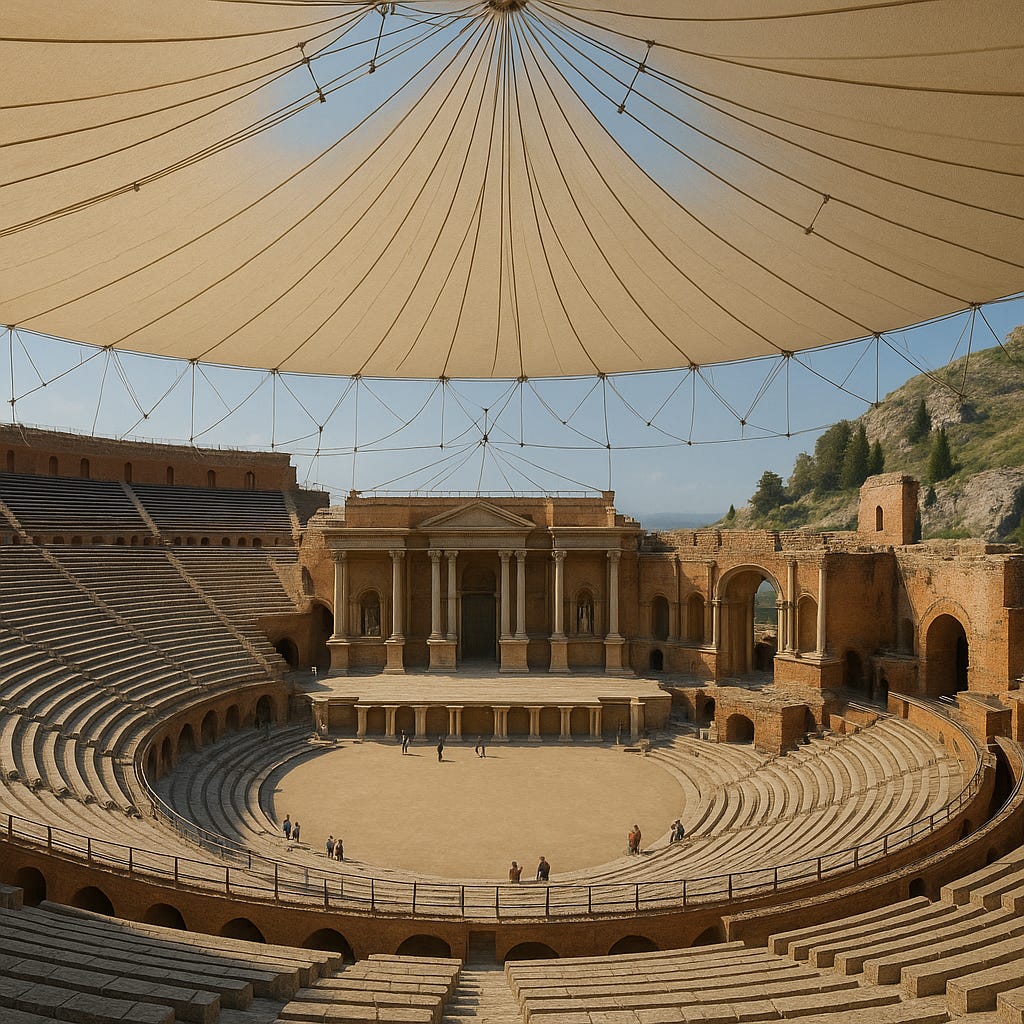See the World Differently with AI
Open Your Eyes and your Mind
In this edition:
My thoughts
Notable headlines
Learning, Tools, and Experiments
AI MISTAKES
My Thoughts
Technology. History. Travel.
These three things all have ‘experience’ in common.
Technology creates a user experience.
History allows us to see the world through the eyes of a time not our own.
And Travel enables us to experience places we otherwise would not have seen.
This month, I’ve had a chance to ‘experience’ all three in a completely new way.
I was incredibly blessed to travel to Europe with my family, and it wouldn’t be AI MISTAKES if I didn’t bring along some AI to enjoy the trip fully!
Before we dive into the headlines, I'd like to share some brief observations with you. I’ve seen the world, but also in some new and unexpected ways. With the power of AI, I’m able to take you with me in more ways than one!
For this trip, I was able to connect with AI in 3 special ways:
Meta Ray-Ban AI-enabled glasses
Replit AI coding
AI in my pocket to fill in all the places that still needed more insights.
No buyer’s remorse on the glasses, but not because the AI wowed me. It was the freedom from screens that made the difference.” More details on that later (subscribe to the YouTube channel to see my review and deeper coverage of the Meta Ray-Ban glasses), but I must tell you that I was able to see and experience the trip without suffering behind an LCD screen viewfinder, which for me was a fantastic benefit!
Now, for the second way, I have to share with you that every time I take a trip, I nearly always lament that I haven’t fully captured the time away because I neglected to record my experiences. The good news is that we can now code our own journaling app, perfectly tailored for the trip! The bad news is, you still have to be intentional about putting things into the journal.
And for the third way, I think it’s fair to say that being a tour guide is about to get more interesting. For much of our tourist visits, we benefited from a paid guide. That makes for a more expensive trip, but you come away with far more than you expect, as you gain better insights and details that you wouldn't have obtained on your own. But a funny thing happened along the way. The added details the guides provided only served to whet my appetite for information, and my handy AI apps (Perplexity and ChatGPT) were there to fill out my experience with much more detail.
The good news is that what you take away from travel stands to improve substantially over the next few years. The bad news is that there is no excuse for a bad guided tour now, because, honestly, anyone should be able to gather the necessary contextual information to have a completely informed experience. In the few places I tried it, snapping a picture of a monument or cityscape nearly always provided exactly the supplemental information I was looking for, and often without much more than a quick snapshot and a question prompting the information I was seeking.
All in all, it was a fantastic trip, made all the better by taking the world’s information along so that I could fully appreciate all that we saw.
And speaking of seeing with AI, the most fantastic part is that all of it was pretty low effort’s that led to an enriching experience for my family and I along the way.
One of the most exciting moments for me was generating the image above of the Ancient Theatre of Taormina in Taormina, Sicily, Italy.
Below is the wide shot I took (on the iPhone from the top of the location) myself while visiting. However, while the tour guide was explaining the environment, I thought, “I wonder what a graphic rendering would look like if this were on the History Channel?”
Admittedly, the generated image was a one-shot with ChatGPT’s GPT-1 image model, but I didn’t exactly go out of my way to make the prompt. I just used the “valorum covering” context that the tour guide provided.
The Roman theater at Taormina complete render of ancient architecture complete with Valorium covering It captured all the key details fairly well, and it took only about a minute. It certainly doesn’t have anything on the actual, detailed work that researchers put together for a highly researched and detailed version. Still, it was a great way to augment what I was experiencing in person at that moment.
We had many great experiences, but one in particular was had while in harbor at Palma de Mallorca, Spain. After we’d returned from our tour of the city, and while vibe-coding more apps with Replit while sitting on the balcony, I noted a half-dozen incredible yachts in the harbor.
My curiosity got the best of me, so while still wearing my Meta glasses, I asked, “Hey Meta, tell me about these yachts over here.”
I got the rather disappointing reply:
There are several yachts docked in the marina, with a variety of sizes and styles. Some have sleek, modern designs, while others appear more traditional or classic.
I did not pursue the matter any further with the embedded Llama model. So, then I asked ChatGPT. Yeah, I had a pretty good idea that one of the Yachts was for Mark Zuckerberg and another for Jeff Bezos. (See the ChatGPT conversation here.) It was inconclusive and used the images for location context rather than ship recognition. Still, honestly, I was impressed with the level of details provided by ChatGPT 4o, and it was a simple prompt along with two pictures:
“What can you tell me about these yachts” Granted, it’s still not fair to put an on-device model up against the giant GPT-4o, but it just goes to show how far we’ve come in only a few years.
So as you’re traveling to and from with your friends and family to places near and far, take a moment and ask the AI in your pocket about what you see, you never know when it might take you to a whole new place of understanding the world.
Notable Headlines
Google
Gemini CLI (This page details Gemini models and their capabilities, including CLI access): Google introduced Gemini CLI, a free AI tool that brings Gemini's coding and research powers directly into developers' terminals.
Gemma 3n: Google is opening up access to Gemma 3n, a mobile-first model for building on-device apps across text, images, audio, and video.
Android XR (General AI updates, often includes mentions of new hardware integrations): Google unveiled new smart glasses powered by Android XR and integrated with the Gemini model family, offering real-time captions, directions, translations, and a personal assistant.
OpenAI
o3-pro and o4-mini: OpenAI released o3-pro, their latest "reasoning-first" model, and o4-mini, a smaller, cost-efficient reasoning model.
AI Hardware Device: OpenAI, in collaboration with Jony Ive’s startup io, is reportedly working on a portable AI device, hinting at OpenAI’s hardware ambitions. **UPDATE: The page has been removed, so I’ve linked to an alternative article.
Anthropic
Claude Code: Anthropic launched Claude Code, a coding agent previously offered as a research preview, along with a Claude Code software development kit.
Project Vend: Anthropic conducted an experiment called Project Vend, where Claude Sonnet 3.7 ran a vending shop, demonstrating limitations in economic tasks requiring persistence, judgment, and autonomy.
AI Fluency Course: Anthropic launched a new AI Fluency course designed to help individuals collaborate with AI systems effectively, efficiently, ethically, and safely.
Apple Considers OpenAI/Anthropic for Siri: Apple is reportedly considering using AI technology from OpenAI or Anthropic to power its digital assistant Siri. **UPDATE: Just before publication, posts on X/Twitter indicated they have selected Anthropic
Meta
Meta's Offers $100 Million Sign-On Bonuses to Lure OpenAI Talent: Meta is shaking up the AI world with eye-popping $100 million sign-on bonuses, all in an ambitious bid to woo top talent from OpenAI.
Oakley Meta Glasses Announced: Meta and Oakley are collaborating to deliver a new category of “Performance AI glasses”.
Learning, Tools, and Experiments
This month, the best experiments are in CLI. Both Google and Anthropic dropped tools that help you code. Use the news links to get into Google’s Gemini CLI for free, and Anthropic’s Claude Code will cost you a subscription (or at least a sign-up for a free trial).
I can also recommend a past tool I shared called Warp, which is an AI-enabled CLI or Terminal app.
AI MISTAKES
Even as AI opens our eyes to new possibilities, it sometimes sees the world wrong, and those mistakes can be illuminating too. A case in point: an AI-written travel article infamously recommended tourists visit the “beautiful” Ottawa Food Bank when exploring Canada’s capital, euronews.com. Yikes! That’s not the kind of attraction either locals or tourists want from a tour guide!
The episode was a reminder that while AI can compile facts, it doesn’t grasp nuance or appropriateness like a human does. In this case, the algorithm knew the food bank existed and had high “interest,” but lacked the common sense to realize it’s not a tourist attraction.
On a different front, AI image generators have been busy reimagining historical scenes – sometimes too convincingly.
Online communities have been captivated by a wave of black-and-white “photos” depicting historical events: a mother and child during the Great Depression, soldiers in World War II, and ancient wonders of the world. The problem is that many of these viral images are complete AI fabrications, theglobepost.com.
What can we learn from these missteps?
First, AI doesn’t intend to get things wrong, but it will confidently present false or context-blind outputs if we’re not careful.
Travel AIs don’t have lived experience; they juggle data.
Vision AIs don’t know the truth; they pattern-match pixels.
As end-users, we have to provide the missing judgment. Double-check the recommendations before following them blindly, especially if you're using them to navigate a tourist spot. We received numerous advisories from our tour guide to be cautious of pickpockets and people who are less than welcoming to tourists.
Use AI as an aid, but still rely on traditional maps and information to guide your path.
In short, keeping humans in the loop is key.
AI can help us see differently, but we must not close our eyes to its flaws.
After all, making MISTAKES is a fundamental part of learning, for humans and AIs alike. The goal isn’t to avoid all errors (impossible), but to catch them, understand them, and build better tools as a result. By doing so, we ensure that AI truly augments our reality, rather than distorting it.
Let’s make July the month to see the world from a new perspective!
Safe travels, and stay curious!
Go see the world and use AI to help you navigate it and share new experiences the world over. And make some meaningful AI MISTAKES along the way.
If you’re enjoying my newsletter, I'd appreciate it if you could share it with someone who could benefit from this valuable information.





Great point regarding AI’s unintentional mistakes and hence key role for us to remain - vigilantly, constructively in the loop. Thanks, Daniel as always for prompting us to reflect - positivity.